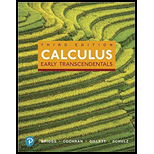
Concept explainers
Free fall An object in free fall may be modeled by assuming that the only forces at work are the gravitational force and air resistance. By Newton’s Second Law of Motion (mass × acceleration = the sum of the external forces), the velocity of the object satisfies the
where f is a function that models the air resistance (assuming the positive direction is downward). One common assumption (often used for motion in air) is that f(v) = – kv2 , where k > 0 is a drag coefficient.
a. Show that the equation can be written in the form v'(t) = g – av2, where a = k/m.
b. For what (positive) value of v is v′(t) = 0? (This equilibrium solution is called the terminal velocity.)
c. Find the solution of this separable equation assuming v(0) = 0 and 0 < v2 < g/a.
d. Graph the solution found in part (c) with g = 9.8 m/s2, m = 1, and k = 0.1, and verify that the terminal velocity agrees with the value found in part (b).
Trending nowThis is a popular solution!

Chapter 9 Solutions
CALCULUS:EARLY TRANSCENDENTALS-PACKAGE
Additional Math Textbook Solutions
A Problem Solving Approach To Mathematics For Elementary School Teachers (13th Edition)
Introductory Statistics
Algebra and Trigonometry (6th Edition)
Thinking Mathematically (6th Edition)
University Calculus: Early Transcendentals (4th Edition)
- Which degenerate conic is formed when a double cone is sliced through the apex by a plane parallel to the slant edge of the cone?arrow_forward1/ Solve the following: 1 x + X + cos(3X) -75 -1 2 2 (5+1) e 5² + 5 + 1 3 L -1 1 5² (5²+1) 1 5(5-5)arrow_forwardI need expert handwritten solution.to this integralarrow_forward
- Example: If ƒ (x + 2π) = ƒ (x), find the Fourier expansion f(x) = eax in the interval [−π,π]arrow_forwardExample: If ƒ (x + 2π) = ƒ (x), find the Fourier expansion f(x) = eax in the interval [−π,π]arrow_forwardPlease can you give detailed steps on how the solutions change from complex form to real form. Thanks.arrow_forward
- Examples: Solve the following differential equation using Laplace transform (e) ty"-ty+y=0 with y(0) = 0, and y'(0) = 1arrow_forwardExamples: Solve the following differential equation using Laplace transform (a) y" +2y+y=t with y(0) = 0, and y'(0) = 1arrow_forwardπ 25. If lies in the interval <0arrow_forwardarrow_back_iosSEE MORE QUESTIONSarrow_forward_ios
